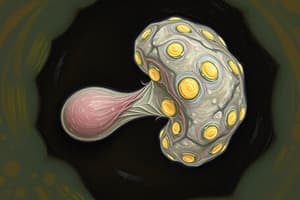Podcast
Questions and Answers
Select the correct electron configuration for Na+
Select the correct electron configuration for Na+
- 1s22s22p53s1
- 1s22s22p6 (correct)
- 1s22s22p63s1
- 1s22s22p63s2
What is the electron configuration for Na+?
What is the electron configuration for Na+?
1s22s22p6
Using the periodic table, fill in the missing component of the electron configuration for magnesium. Mg = 1s22s22p63s___
Using the periodic table, fill in the missing component of the electron configuration for magnesium. Mg = 1s22s22p63s___
2
What is the missing piece of the electron configuration for Mg?
What is the missing piece of the electron configuration for Mg?
Which pair of elements will have a similar valence shell electron configuration?
Which pair of elements will have a similar valence shell electron configuration?
What is the valence shell electron configuration of nitrogen?
What is the valence shell electron configuration of nitrogen?
Select the correct electron configuration for F−
Select the correct electron configuration for F−
Are there unpaired electrons in phosphorus? If so, how many?
Are there unpaired electrons in phosphorus? If so, how many?
How many electrons can be found in an individual orbital?
How many electrons can be found in an individual orbital?
Select the correct electron configuration for Cr.
Select the correct electron configuration for Cr.
How many d electrons are found in cobalt?
How many d electrons are found in cobalt?
Which electrons are lost in the formation of the Sn4+ cation?
Which electrons are lost in the formation of the Sn4+ cation?
Which set of orbitals can hold a maximum of 14 electrons?
Which set of orbitals can hold a maximum of 14 electrons?
How many valence electrons are present in sulfur?
How many valence electrons are present in sulfur?
Identify what is wrong in the electron configuration for Ca = 1s11s22s22p63s23p64s2.
Identify what is wrong in the electron configuration for Ca = 1s11s22s22p63s23p64s2.
Which energy level is the closest to the nucleus?
Which energy level is the closest to the nucleus?
Metals tend to _______ electrons to form _______.
Metals tend to _______ electrons to form _______.
Select the correct electron configuration for Na+
Select the correct electron configuration for Na+
Flashcards are hidden until you start studying
Study Notes
Electron Configurations
- Na+ has an electron configuration of 1s²2s²2p⁶, achieved by losing one electron from the neutral sodium atom (1s²2s²2p⁶3s¹).
- Magnesium (Mg) has an electron configuration of 1s²2s²2p⁶3s², indicating the presence of two electrons in the 3s subshell.
- Chromium (Cr) has a unique electron configuration of 1s²2s²2p⁶3s²3p⁶4s¹3d⁵, due to the stability conferred by half-filling the d subshell.
Valence Electrons
- Nitrogen (N) has a valence shell electron configuration of 2s²2p³, while phosphorus (P) has 3s²3p³, resulting in both having five valence electrons.
- Similarities in valence configurations are exhibited between elements in the same column of the periodic table.
Unpaired Electrons
- Phosphorus contains 3 unpaired electrons in its valence shell, signifying its potential for bonding and magnetic properties.
Orbital Capacity
- Individual orbitals can hold a maximum of 2 electrons, irrespective of the orbital type (s, p, d, f).
- f orbitals can accommodate up to 14 electrons due to the presence of seven f orbitals.
Cation Formation
- Cations are formed by metals losing electrons. For example, Sn4+ is created by removing four electrons from its 5p and 5s subshells.
Energy Levels
- The energy level closest to the nucleus is n=1, with subsequent levels at n=2, n=3, etc.
Element Abundancy
- Oxygen is recognized as the most abundant element on Earth, emphasizing its significance in various chemical processes.
Errors in Electron Configurations
- Misconfigurations can occur, such as writing Ca = 1s¹ instead of 1s², highlighting the importance of accuracy in electron representations.
Studying That Suits You
Use AI to generate personalized quizzes and flashcards to suit your learning preferences.




